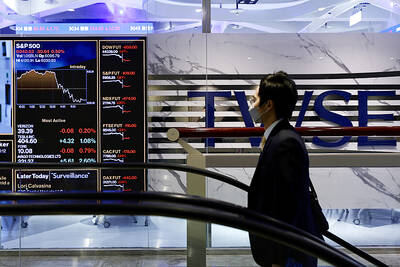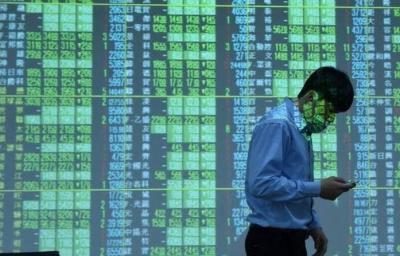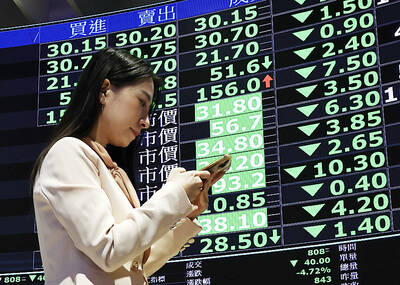AU Optronics Corp (AUO, 友達光電) yesterday said the first quarter of this year was its best first quarter in the past nine years as persistent inventory buildup demand for TV panels pushed prices higher.
The LCD panel maker’s net profit expanded about 5.7 percent to NT$9.48 billion (US$314.4 million), compared with NT$8.97 billion in the fourth quarter of last year, the company’s financial statement showed.
In the first quarter of last year, the company lost NT$5.48 billion.
Average selling prices for the company’s products rose 2 percent in the first quarter to US$421 per square meter, up from US$413 per square meter in the fourth quarter of last year.
That represents an annual jump of 20.63 percent.
“TV vendors continued to replenish inventory in the first quarter. Robust demand has caused a supply crunch,” AUO chairman and chief executive officer Paul Peng (彭双浪) told investors.
“The robust demand is to extend into the second quarter. AUO expects its equipment loading rate to remain at a high gear, or to be almost fully loaded,” he said.
“This will be the longest boom period in the LCD industry’s history. We expect the prosperity to be in place for some time,” he said.
The company said it expects demand growth to outpace supply by about 2 percent this year.
However, it is keeping its capital spending for this year at NT$55 billion, as planned at end of last year.
AUO expects its shipments of PC and TV panels this quarter to shrink by a low-single-digit percentage by unit as it is to ship more large-size and high-end TV panels, such as 65-inch TV panels and 55-inch ultra-high-definition 4K TV panels, which will consume more capacity.
“As TV sets become slimmer, the uptake of 65-inch and 70-inch TVs is improving,” AUO president Michael Tsai (蔡國新) said. “Clients are also asking for more supply of such panels.”
Prices for TV panels are expected to rise by a low-single digit percentage this quarter from last quarter, AUO said.
However, exchange rates might have a greater impact on the company’s business in the first half of the year, Peng said.
A stronger New Taiwan dollar would weaken AUO’s price competitiveness, he said.
Against the US dollar, the NT dollar appreciated 5.6 percent in the first quarter of the year, faster than South Korean won’s 4.1 percent, while Chinese yuan fell 5.3 percent, he said.
AUO also said it has made significant progress this year in expanding its client base for OLED panels.
Monthly shipments of OLED panels for wearable devices, mostly smart watches, are expected to reach 1 million units in the second half of the year, the company said.

SELL-OFF: Investors expect tariff-driven volatility as the local boarse reopens today, while analysts say government support and solid fundamentals would steady sentiment Local investors are bracing for a sharp market downturn today as the nation’s financial markets resume trading following a two-day closure for national holidays before the weekend, with sentiment rattled by US President Donald Trump’s sweeping tariff announcement. Trump’s unveiling of new “reciprocal tariffs” on Wednesday triggered a sell-off in global markets, with the FTSE Taiwan Index Futures — a benchmark for Taiwanese equities traded in Singapore — tumbling 9.2 percent over the past two sessions. Meanwhile, the American depositary receipts (ADRs) of Taiwan Semiconductor Manufacturing Co (TSMC, 台積電), the most heavily weighted stock on the TAIEX, plunged 13.8 percent in

A wave of stop-loss selling and panic selling hit Taiwan's stock market at its opening today, with the weighted index plunging 2,086 points — a drop of more than 9.7 percent — marking the largest intraday point and percentage loss on record. The index bottomed out at 19,212.02, while futures were locked limit-down, with more than 1,000 stocks hitting their daily drop limit. Three heavyweight stocks — Taiwan Semiconductor Manufacturing Co (TSMC, 台積電), Hon Hai Precision Industry Co (Foxconn, 鴻海精密) and MediaTek (聯發科) — hit their limit-down prices as soon as the market opened, falling to NT$848 (US$25.54), NT$138.5 and NT$1,295 respectively. TSMC's

TARIFFS: The global ‘panic atmosphere remains strong,’ and foreign investors have continued to sell their holdings since the start of the year, the Ministry of Finance said The government yesterday authorized the activation of its NT$500 billion (US$15.15 billion) National Stabilization Fund (NSF) to prop up the local stock market after two days of sharp falls in reaction to US President Donald Trump’s new import tariffs. The Ministry of Finance said in a statement after the market close that the steering committee of the fund had been given the go-ahead to intervene in the market to bolster Taiwanese shares in a time of crisis. The fund has been authorized to use its assets “to carry out market stabilization tasks as appropriate to maintain the stability of Taiwan’s

In a small town in Paraguay, a showdown is brewing between traditional producers of yerba mate, a bitter herbal tea popular across South America, and miners of a shinier treasure: gold. A rush for the precious metal is pitting mate growers and indigenous groups against the expanding operations of small-scale miners who, until recently, were their neighbors, not nemeses. “They [the miners] have destroyed everything... The canals, springs, swamps,” said Vidal Britez, president of the Yerba Mate Producers’ Association of the town of Paso Yobai, about 210km east of capital Asuncion. “You can see the pollution from the dead fish.